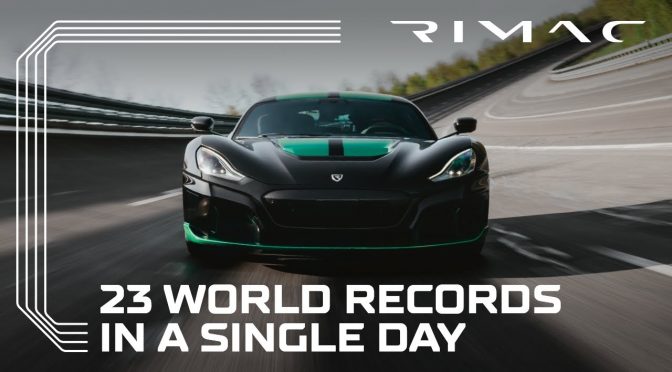The Rimac Nevera, a remarkable two-seat all-electric hypercar, has redefined the limits of automotive performance by shattering 23 world records. This engineering marvel has shown that it is not just another electric vehicle, but a force to be reckoned with in the performance automotive industry. Boasting state-of-the-art technology, impressive power outputs, and unparalleled speed, the Nevera exhibits a harmonious blend of high-performance capability and futuristic technology. Watch the embedded video to witness the capabilities of this phenomenal hypercar as it brakes the records.
Unprecedented Performance Prowess
The Nevera’s stunning performance is headlined by its incredible acceleration, with the car reaching 60 mph in a staggering 1.74 seconds, and powering to 180 mph in just 9.22 seconds. Its quarter-mile time sits at a mere 8.25 seconds, and it achieves a breathtaking top speed of 258 mph (415 kmh). At the heart of this beast lies an extraordinary power output of 1,914 horsepower (1.4 MW) and a maximum torque of 2,360 Nm.
In a display of its prowess, the Nevera accomplished more than 20 acceleration and braking records, including a particularly challenging feat — achieving the 0 to 60 mph time under 1.8 seconds on street tires on a prepped surface on normal asphalt. This required everything, including outdoor and tire temperatures, and tire pressures, to be in perfect alignment.
State-of-the-Art Technology
The Nevera owes its record-breaking performance to its sophisticated technological infrastructure. To ensure accuracy in performance measurements, Rimac partnered with Devisoft and Race Logic. The car was equipped with the latest Navion and a Race Logic P-box, using both GPS data and internal accelerometers for precise data collection and performance measurement.
The Nevera uses standard aerodynamic configuration up to speeds of 350 kph. However, for higher speeds, a special aerodynamic configuration was necessary to maintain stability and performance. Furthermore, it features a state-of-the-art braking system that combines regenerative braking from the electric motors and friction brakes from Brembo, which are carbon ceramic with six-piston calipers at the front.
More details
Limited to just 150 units globally, the Nevera’s power comes from its four motors. The two front motors deliver 307 hp each, while the rear motors pump out an impressive 612 hp each. The hypercar’s 120 kWh battery pack, consisting of 6960 lithium manganese nickel cylindrical cells, can be fast-charged using a 500 kW DC Combo in just 19 minutes from 0 to 80% state of charge (SOC).
The car also features an advanced driver assistance system, equipped with 13 cameras, 6 radars, and 12 ultrasonic sensors. Its dimensions provide a commanding presence, with a length of 4750 mm, width of 1986 mm, height of 1208 mm, and a wheelbase of 2745 mm. Despite its heft, weighing in at 2300 kg, the Nevera shows remarkable electricity consumption efficiency across various driving conditions.
The Record-Breaking Journey
During the record-breaking day, the Rimac team aimed to break seven outperforming records, but the most significant challenge was the zero to 400 to 0 kph time. This record demands not just a tremendous initial acceleration, but also requires the car to decelerate from high speeds in a timely and controlled manner. The team’s joy was palpable when they beat the world record, demonstrating the Nevera’s balanced excellence in both acceleration and braking.
To validate these records and maintain the utmost accuracy, the Rimac team employed a stringent process. They invited two crucial partners, Devisoft and Race Logic, to measure the performance and validate the records. State-of-the-art navigation and data acquisition technology, including the latest Navion and Race Logic P-Box, were used to collect precise performance data. This tech-savvy approach ensured transparency, accuracy, and reliability in the record-breaking attempts.
Diving into Record-Breaking Feats
The Rimac Nevera’s exceptional performance stems from an optimal blend of superior control systems and conducive conditions. The driver amusingly suggested that setting most of the records was as effortless as eating an ice cream, underlining the vehicle’s impressive ease of operation and high-speed stability.
Nevertheless, the record of hitting 0-60 mph under 1.8 seconds on street tires proved a more challenging endeavor. This achievement necessitated perfect conditions, including specific outdoor and tire temperatures as well as precise tire pressures. The equilibrium between the control systems, ambient weather conditions, and tire conditions played a crucial role in conquering this record.
Once the vehicle hit the 350 kph threshold, a specialized aerodynamic configuration was needed to preserve its stability and performance. The transition from the standard aerodynamic configuration was necessary to counter the high-speed aerodynamic pressures. These intricate details underscore the meticulous consideration invested in every facet of the car’s performance while pushing speed and control boundaries.
The results were nothing short of astounding, confirming the Rimac Nevera’s extraordinary abilities as seemingly ‘not from this Earth’. Breaking 23 records wasn’t just a landmark achievement; it symbolized Rimac’s persistent quest for performance and excellence. With such groundbreaking capabilities, the Rimac Nevera has set new standards in the world of high-performance vehicles.
Concluding
Rimac’s Nevera is not just a symbol of electric vehicle potential — it’s a testament to the remarkable capabilities of human engineering and technological innovation. Breaking 23 performance world records, it stands as a titan of speed, power, and efficiency, pushing the boundaries of what we know to be possible in the automotive industry.

